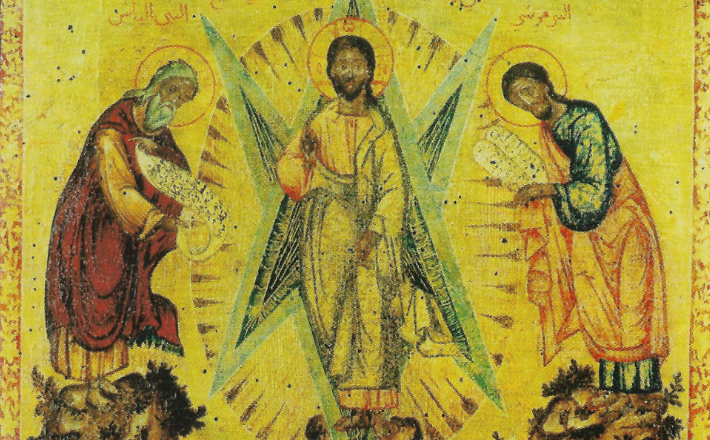Commentary on Luke 9:28-45
Luke Timothy Johnson’s The Gospel of Luke commentary emphasizes a reading strategy that aims to “clarify not only what the writing says but also how it speaks.”1 Preachers know this intuitively: How we say what we say is at least as important as what is said and, in some cases, decisive. Suggestive in this regard, and unlike Mark 9:2 and Matthew 17:1, Luke introduces the transfiguration with Jesus’ intention to pray and to continue in prayer (9:28–29). Jesus’ “prayer experience,” as Johnson calls it, supplies a clue to the quality of voice permeating this story, and gives insight for how we might hear it too.2
Johnson identifies this text as one of three closely related scenes, including Peter’s confession (9:18–22) and the cost of discipleship (9:23–27). Altogether, these three episodes lead disciples and readers into contemplation of Jesus’ identity and a sharpened sense of calling. As to what we hear in the Lukan transfiguration account:
- Along with the disciples, we see the “appearance of [Jesus’] face changed, and his clothes became dazzling white” (verse 29). Note: unlike the other Synoptics, Luke avoids the verb metamorphoō (“change of form = transfigure”) and uses eidos (“appearance”) instead;
- We eavesdrop on a conversation between Jesus, Moses, and Elijah as they talk about his exodos (“departure,” verse 31, New Revised Standard Version);
- We recognize the “impaired” Christology of Peter, John, and James through their struggle to keep awake and seeing the vision only as it fades from sight (verse 32), and Peter’s failed attempt to sort out this phenomenal experience in a way that made “conventional” sense (verse 33);
- We feel a kind of vertigo triggered by multiple phenomena, source unknown or undisclosed, including light (verses 29, 31, 32), abrupt departures (verse 33), the rising of a cloud (verse 34), and the divine voice from the cloud, designating Jesus as Son and Elected One, and a command: “Listen to him!” (verse 35).
This is not a time to build, or even to speak, but to be still … and listen.
They kept their silence, but how much the disciples understood is difficult to say. The next day, down the mountain and amid life’s fevers, they show that they have not yet grasped what or who had grasped them on the mountain—when a father pleads with them to do what Jesus does, the disciples “could not” do it (verse 40). Later, when confronted again with Jesus foretelling his suffering, they do not understand and do not ask further; instead, they argue about who would be the greatest among them. In the King James Version, Jesus “perceiv[es] the thought of their heart”—the fever-prayer that continues to impair their perception and vocation (verse 47).
Johnson concludes: “These would-be leaders of the people still have much to learn: they are not in charge but under a charge.”3
Reflections
The richness of this account may result, ironically, in a flat or superficial encounter. We simply shut down, almost feeling assaulted by the over-saturation of movement, light, cloud, voices, and abrupt withdrawal. “Polyphonic” is a word that comes to mind: Diverse phenomena groan with Jesus’ prayer experience—and this might be one clue to how we hear the content of the text.
The transfiguration text represents a spectacular moment in the Jesus story—each of the Synoptics includes it, but equally, none of the Synoptics stay in that place. Luke’s Jesus pushes us into the fray, into the fever, into the place where we try, get it right, or get it wrong, or get it confused. If there is a kind of “truth” in the transfiguration, it is not a truth that we can hold tightly, but it is rather a truth that can only be understood by way of release.4
It is truth as sacred as the Eagle feather in an Elder’s open hand—barely a breath, and it moves, prayer-like, between you and me.
How does the truth of transfiguration insinuate itself into our world today? Just now, for example, I think of inverting the metaphor of holy mountain with the sacred carbon sink; or the troubled crowds in the valley with a clear-cut area of old-growth forest, herbicides decimating tens of thousands, if not millions, of years of mycorrhizal diversity and our seeming powerlessness to repair that damage; or maybe I correlate the disciples’ half-awareness of Moses, Elijah, and Jesus talking about exodus, with our impaired “hearing” of the subterranean communication beneath the forest floor.
This conversation is going on all the time, according to Suzzanne Simard, ecologist, forest activist, and Indigenous ally. Her research revolutionized forestry by demonstrating the close networks not only of fierce competition but also of cooperation, especially between what she terms “hub trees” or “mother trees,” which show that being connected to these ancients is helpful to younger forests. Simard explains that
the trees are in communion with the fungi beneath [our] feet—bartering carbon for water and nutrients in a raucous exchange older than the forests themselves. Crouching low, Simard pulls a trowel from her pocket and cuts deep into the earth, through layers of moss, duff and debris. “See this?” In her cupped hands, she holds a palmful of soil flecked with thin, white filaments. “Mycorrhizal fungi,” she says. “It’s joining all these trees together.”5
She almost seems to say, “Listen to Mother Tree!”
Is Jesus’ transfiguration something like really seeing an old-growth stand of Douglas fir, seeing it at depth for the first time? To us, it seems like Jesus has changed somehow, because we “see” or “hear” his message. Of course, Jesus didn’t change, not really. And neither did the Douglas fir. But maybe we did.
Notes
- Luke Timothy Johnson, The Gospel of Luke, Sacra Pagina, vol. 3, ed. Daniel J. Harrington, SJ (Collegeville: The Liturgical Press, 1991), 2.
- Johnson, 152.
- Johnson, 161.
- For the concept of truth as process, see Graham Adams, Holy Anarchy: Dismantling Domination, Embodying Community, Loving Strangeness (London: SCM Press, 2022).
- Sarah Kaplan, “On a mission to Save ‘Mother Trees,’” The Washington Post, December 27, 2023, accessed September 25, 2024, https://www.washingtonpost.com/climate-solutions/interactive/2022/suzanne-simard-mother-trees-climate/.
PRAYER OF THE DAY
Dazzling Lord,
In blinding light you showed your disciples a hint of your power and purpose. Reveal yourself to us today. Show us what you desire of us and how to broadcast your love to the world, for the sake of the one who keeps company with the prophets Moses and Elijah, Jesus Christ our Lord. Amen.
HYMNS
How good, Lord, to be here! ELW 315
Oh, wondrous image, vision fair ELW 316, H82 136, 137, UMH 258, NCH 184 Jesus on the mountain peak ELW 317
Shine, Jesus, shine ELW 671
CHORAL
The Exaltation of Christ, Charles Forsberg


March 2, 2025